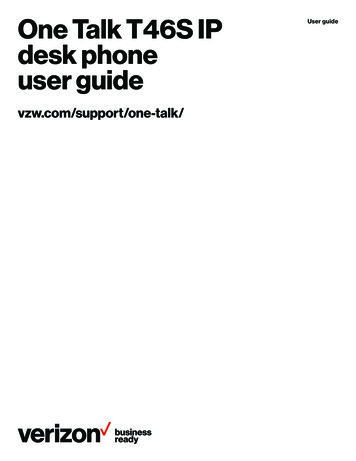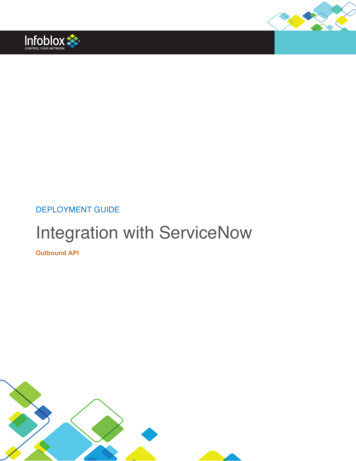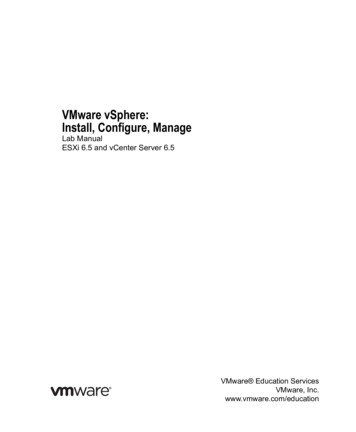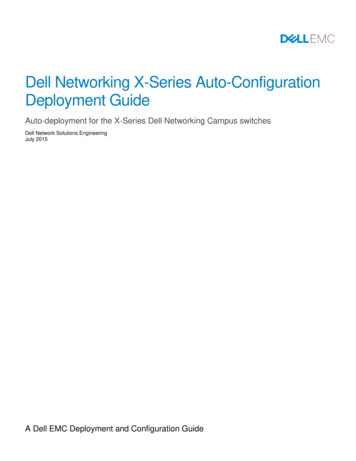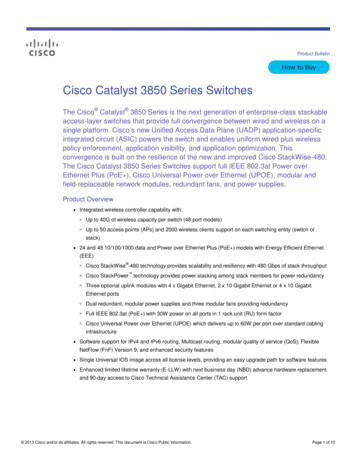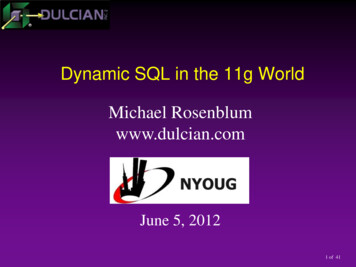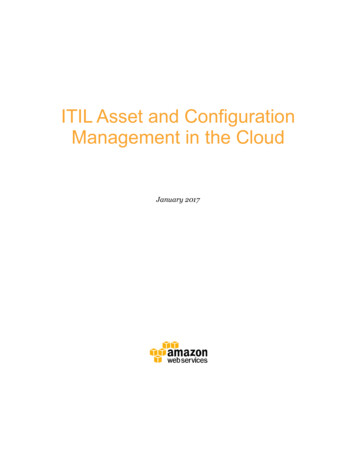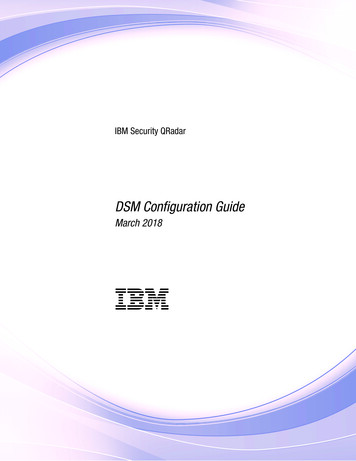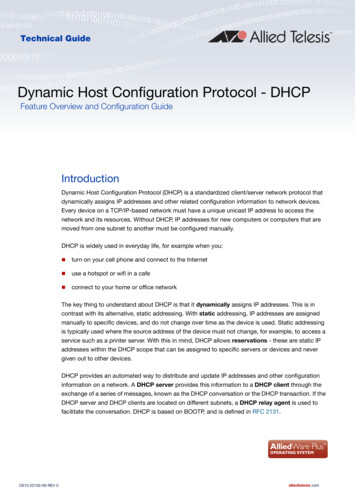
Transcription
Technical GuideDynamic Host Configuration Protocol - DHCPFeature Overview and Configuration GuideIntroductionDynamic Host Configuration Protocol (DHCP) is a standardized client/server network protocol thatdynamically assigns IP addresses and other related configuration information to network devices.Every device on a TCP/IP-based network must have a unique unicast IP address to access thenetwork and its resources. Without DHCP, IP addresses for new computers or computers that aremoved from one subnet to another must be configured manually.DHCP is widely used in everyday life, for example when you: turn on your cell phone and connect to the Internet use a hotspot or wifi in a cafe connect to your home or office networkThe key thing to understand about DHCP is that it dynamically assigns IP addresses. This is incontrast with its alternative, static addressing. With static addressing, IP addresses are assignedmanually to specific devices, and do not change over time as the device is used. Static addressingis typically used where the source address of the device must not change, for example, to access aservice such as a printer server. With this in mind, DHCP allows reservations - these are static IPaddresses within the DHCP scope that can be assigned to specific servers or devices and nevergiven out to other devices.DHCP provides an automated way to distribute and update IP addresses and other configurationinformation on a network. A DHCP server provides this information to a DHCP client through theexchange of a series of messages, known as the DHCP conversation or the DHCP transaction. If theDHCP server and DHCP clients are located on different subnets, a DHCP relay agent is used tofacilitate the conversation. DHCP is based on BOOTP, and is defined in RFC 2131.C613-22102-00 REV Calliedtelesis.com
Dynamic Host Configuration Protocol - DHCPProducts and software version that apply to this guideThis guide applies to all AlliedWare Plus products, running version 5.4.4 or later.For more information, see the following documents: The product’s Datasheet The product’s Command ReferenceThese documents are available from the above links on our website at alliedtelesis.com.ContentsIntroduction .1Products and software version that apply to this guide .2Benefits of DHCP .3Network users.3Network administrators.3How does DHCP work .4DHCP Architecture .5DHCP client .5DHCP server .5DHCP relay agent .5The DHCP process .7Configuring DHCP.8Configuring the DHCP client.8Configuring the DHCP server .9Configuring the DHCP relay agent.14DHCP relay agent information option (Option 82) .15DHCP Relay Client Side IP Source Address.17Configuring a DHCP short lease threshold.19C613-22102-00 REV CProducts and software version that apply to this guide Page 2
Dynamic Host Configuration Protocol - DHCPBenefits of DHCPDHCP provides many benefits for network administrators, network users, and people usingconsumer gadgets such as mobile phones, tablets, and laptops to connect to the network. Thissection focuses on the benefits for network users and network administrators.Network usersDHCP provides network users with ‘plug and play’ networking. This means that network users cantravel anywhere on the network and automatically receive an IP address when they reconnect to thenetwork.Network administratorsDHCP provides network administrators with quicker and more reliable IP address configuration.DHCP minimizes configuration errors caused by manual IP address configuration, such astypographical errors, or address conflicts caused by the assignment of an IP address to more thanone computer at the same time.Network administrators find DHCP useful when they want to change the IP addresses of a largenumber of systems. Instead of reconfiguring all the systems, they can just edit one DHCPconfiguration file on the server for the new set of IP addresses. If the DNS server for an organizationchanges, the changes are made on the DHCP server, not on the DHCP clients.Because DHCP is easy to configure, it minimizes operational overhead and costs associated withconfiguration.DHCP includes the following features to reduce network administration: The ability to define TCP/IP configurations from a central location. The ability to assign a full range of additional TCP/IP configuration values by means of DHCPoptions. The efficient handling of IP address changes for clients that must be updated frequently, such asthose for portable computers that move to different locations on a wireless network. The forwarding of initial DHCP messages by using a DHCP relay agent, which eliminates the needfor a DHCP server on every subnet.DHCP also helps conserve limited IP address space, because IP addresses no longer need to bepermanently assigned to hosts.C613-22102-00 REV CNetwork users Page 3
Dynamic Host Configuration Protocol - DHCPHow does DHCP workWhen you access the Internet, your computer automatically requests an IP address from thenetwork’s DHCP server. The DHCP server contains a range (or scope) of IP addresses that it isallowed to give out. If there is an address available, the DHCP server will send your computer aresponse containing an IP address, the default gateway address, subnet mask, and the lease timethat your computer can use the address for.You might ask, “why is the IP address leased?” This is so that the range of IP addresses can berecycled and not used up, or left as ‘used’ by a device that has been disconnected. Leases timesare configured to suit various requirements. For example, a cafe with free wifi may have leases thatlast/expire in 1 day, but in an Enterprise environment such as a call center with 1000 computersusing the same IP addresses from a DHCP server ‘permanently’, they may use a lease of 100 days.This would make sure no undue network traffic was going on simply for renewing an IP address forhosts plugged in all the time.Clients renew their leases (generally at 50% of the lease time), and when the lease is renewed it willusually be the same IP address.Of course, not every device on the network needs to have a dynamic IP address. Using DHCP, youcan reserve addresses for devices such as printers. As each network device has a MAC address,you can assign a static IP at the server to a specific MAC address. This allows devices such as thenetwork printer to always get the same IP address even after it reboots and without assigning the IPaddress at the printer.C613-22102-00 REV CNetwork administrators Page 4
Dynamic Host Configuration Protocol - DHCPDHCP ArchitectureThe DHCP architecture is made up of DHCP clients, DHCP servers, and DHCP relay agents. Theclient interacts with servers using DHCP messages in a DHCP conversation to obtain and renew IPaddress leases.Here is a brief description of the DHCP components:DHCP clientA DHCP client is any IP device connected on the network that has been configured to act as a hostrequesting configuration parameters such as an IP address from a DHCP server. Configurationparameters and other control information are carried in tagged data items that are stored in theOptions field of the DHCP message. DHCP uses the Options to pass additional IP settings to DHCPclients such as the default gateway IP address, DNS server address, and the DNS domain name.For more detail about Options see "Configuring the DHCP client" on page 8.DHCP serverThe DHCP server is a device on the network with a pool of IP addresses at its disposal toautomatically assign to devices as they join the network.The DHCP server assigns the network device its: IP address - dynamically configured subnet mask - statically configured default gateway for the network - statically configured Primary DNS server - to match a device NAME to an IP address Secondary DNS server - statically configured for redundancy and load balancing.DHCP relay agentDHCP relay agents pass DHCP messages between servers and clients where the DHCP server doesnot reside on the same IP subnet as its clients.For example, on large networks consisting of multiple subnets, a single DHCP server may servicethe entire network when aided by DHCP relay agents located on the interconnecting routers. Youcan configure a maximum number of 400 DHCP relay agents (one per interface) on AlliedWare Plusdevices.You can use DHCP relay agent information, Option 82, to protect your switch from spoofing attacks,where untrusted hosts send requests for IP addresses to access the network. For more informationon Option 82 see, "DHCP relay agent information option (Option 82)" on page 15.C613-22102-00 REV CDHCP client Page 5
Dynamic Host Configuration Protocol - DHCPThe following diagram shows the changing port numbers and the source and destination addressesused during the DHCP transaction. UDP port 68 is reserved for DHCP clients, and UDP port 67 isreserved for DHCP servers.Step 1DHCP DiscoverDHCP DiscoverClient port 68Server port 67Source 0.0.0.0 / Destination 255.255.255.255 Sent by the client looking for the IP address. The source IP is 0.0.0.0 because the client doesn’thave an IP address. The destination is 255.255.255.255, which is the broadcast address, as theclient doesn’t know where the DHCP server is located, so it broadcasts to all devices on thenetwork.Step 2DHCP OfferDHCP OfferServer port 67Client port 68Source 192.168.0.1 / Destination 255.255.255.255 Sent by the DHCP server offering an IP address to the client. The source address is the DHCPserver address. The DHCP server doesn’t know the client address yet, so it broadcasts the offerto all devices on the network.Step 3DHCP RequestDHCP RequestClient port 68Server port 67Source 0.0.0.0 / Destination 255.255.255.255 Sent by the client to the DHCP server to say “I will take that IP address, thanks.” The client IPaddress is still 0.0.0.0 and it is again broadcast to all so that any other servers on the network thatmay have offered an IP address will know to stop communicating with the client for now.Step 4DHCP AcknowledgmentDHCP AckServer port 67Client port 68Source 192.168.0.1 / Destination 255.255.255.255 Sent by the DHCP server to the client. It confirms the IP address and other details such as subnetmask, default gateway, and lease time with the client. The source address is the DHCP server andthe destination is still the broadcast address.C613-22102-00 REV CDHCP relay agent Page 6
Dynamic Host Configuration Protocol - DHCPThe DHCP processThere are four basic steps the DHCP process follows when a client connects to the network:1. The client broadcasts a DHCP Discover message to say “I need an IP address, are there anyDHCP servers out there?”2. Multiple DHCP servers may respond (via broadcast) with an OFFER for a leased IP address backto the client.3. The client will choose a DHCP server offer and then broadcast a DHCP REQUEST back to theDHCP server(s) to say “Thanks, I have selected an offer from this DHCP server.” All servers willsee which offer the client selected.4. Finally, the selected DHCP server will send (broadcast) an ACKNOWLEDGEMENT back to theclient to confirm the IP address, lease time, and other details.Figure 1: Basic DHCP questdge4owleAcknLease renewalIf a clients wants to continue using its leased IP address it performs a renewal, generally at 50% ofthe lease time. This follows a simpler process than the initial lease acquisition. The client sends aDHCP REQUEST, requesting the address it is currently using. This time the message is unicast tothe server it originally leased the address from. If the server can allow the client to continue usingthat address, it replies with a DHCP ACK.Releasing an IP addressIf a client no longer wishes to continue using a leased address, it sends a DHCP RELEASE messageto the server. This indicates to the server that the client is no longer using the address and it is freeto be allocated to another client in the future.C613-22102-00 REV CThe DHCP process Page 7
Dynamic Host Configuration Protocol - DHCPConfiguring DHCPThis section describes how to configure the DHCP: Client Server Relay agent Short lease thresholdConfiguring the DHCP clientYou can configure an interface on your device with a static IP address, or with a dynamic IP addressassigned using your device’s DHCP client. When you use the DHCP client, it obtains the IP addressfor the interface, and other IP configuration parameters, from a DHCP server. To configure aninterface and gain its IP configuration using the DHCP client, use the commands:awplus(config)#interface ifname awplus(config-if)#ip address dhcp [client-id interface ] [hostname hostname }The DHCP client supports the following IP configuration options:Table 1: DHCP client optionsOPTION CODEDESCRIPTION1The subnet mask for your device.3A list of default routers.6A list of DNS servers. This list appends the DNS servers set on your device withthe ip name-server command.15A domain name used to resolve host names. This option replaces the domainname set with the ip domain-name command.Your device ignores this domain name if it has a domain list set using the ipdomain-list command.51Lease expiration time.Options are defined when you configure the DHCP server. For information on how to configure theOptions, see "Set the options" on page 12.If an IP interface is configured to get its IP address and subnet mask from DHCP, the interface doesnot take part in IP routing until the IP address and subnet mask have been set by DHCP.To configure a static IP address on an interface, use the ip address command.C613-22102-00 REV CConfiguring the DHCP client Page 8
Dynamic Host Configuration Protocol - DHCPConfiguring the DHCP serverThe DHCP server uses address pools when responding to DHCP client requests. Address poolscontains specific IP configuration details that the DHCP server can allocate to a client. You canconfigure multiple address pools on the device for different networks.To configure an address pool, you must:1. Create the pool and enter its configuration mode.2. Define the network the pool applies to.3. Define the range of IP addresses that the server can allocate to clients. You can specify multipleaddress ranges for each pool.4. Set the lease for the clients. This defines whether the clients receive a dynamic, permanent, orstatic IP address.5. Set the options (standard and user-defined) that the clients of a pool require when configuringtheir IP details.6. After configuring the address pools, enable the DHCP server by using the command:awplus(config)#service dhcp-server For networks where you do not want the server to respond to BOOTP requests, you canconfigure the DHCP server so that it ignores them by using the command:awplus(config)#ip dhcp bootp ignoreCreate the poolA DHCP pool is identified by a name. To create a DHCP pool and enter the DHCP Configurationmode for the pool, use the command:awplus(config)#ip dhcp pool pool-name awplus(dhcp-config)#Define the networkDefine the network that the DHCP clients are in. You can define one network per address pool. Usethe following command to define the network after defining the DHCP pool first:awplus(dhcp-config)#network { ip-subnet-addr/prefix-length ip-subnetaddr/mask For remote clients, set the network address to the network of the remote clients. The networkcommand does not need to match a specific interface’s network, because the DHCP serverlistens on all IP interfaces for DHCP requests. For locally connected clients, ensure that the desired interface has an IP address and subnetmask defined; use the ip address ip-addr/prefix-length command (in interface configurationmode ) to set a static address. Enter the configuration mode for the pool, and set the DHCPaddress pool’s network to match the interface’s network. Pools that span multiple interfaces arepossible only if the interface networks are contiguous.C613-22102-00 REV CConfiguring the DHCP server Page 9
Dynamic Host Configuration Protocol - DHCPDefine the rangeConfigure an IP address range for the pool. This range must be in the same subnet as the pool’snetwork setting. Use the command:awplus(dhcp-config)#range ip-address [ ip-address ]The first IPv4 address specifies the low end of the range, while the second IP address is the highend. You can set the range to a single IP address by specifying only one IP address.Set the leaseThe DHCP server assigns IP settings to hosts for specific times (the lease time). Each DCHP poolhas one lease time setting. You can use DHCP to allocate the following types of addresses: A dynamic IP addressThese are available to a host for a limited amount of time. When the lease expires, the server canreallocate the IP address to another device. To set the lease time for the DHCP pool so that itassigns dynamic IP addresses, use the command:awplus(dhcp-config)#lease days hours minutes [ seconds ] A permanent IP addressThese are available to a host for an unlimited amount of time. To set the lease time to assignpermanent IP addresses, use the command:awplus(dhcp-config)#lease infinite A static IP addressThese are allocated to a particular client. The DHCP server recognizes the client by its MACaddress. This lets you use DHCP to manage most of your network automatically, while havingunchanging IP addresses on key devices such as servers. To assign a static IP address to adevice, use the command:awplus(dhcp-config)#host ip-address mac-address BOOTP requests can be satisfied by pools with leases set to infinity.C613-22102-00 REV CConfiguring the DHCP server Page 10
Dynamic Host Configuration Protocol - DHCPEnable DHCP LeasequeryThe DHCP Leasequery protocol (RFC 4388) allows a device or process, for example a DHCP relayagent, to obtain IP address information directly from the DHCP server using DHCPLEASEQUERYmessages.DHCPLEASEQUERY messages support three query regimes:IP address Only an IP address is supplied in the DHCPLEASEQUERY message. The DHCP server will returnany information that it has on the most recent client to have been assigned that IP address.MACaddress Only a MAC address is supplied in the DHCPLEASEQUERY message. The DHCP server willreturn any information that it has on the IP address most recently accessed by a client with thatMAC address. Also, the DHCP server may supply additional IP addresses that have beenassociated with that MAC address in different subnets.Clientidentifieroption Only a client identifier option is supplied in the DHCPLEASEQUERY message. The DHCP serverwill return any information that it has on the IP address most recently accessed by a client withthat client identifier. Also, the DHCP server may supply additional IP addresses that have beenassociated with the client identifier in different subnets.An AlliedWare Plus DHCP server implementing DHCP Leasequery supports all three query regimes.If the DHCP Leasequery feature is enabled, when a DHCP relay agent needs to know the location ofan IP endpoint and sends a DHCPLEASEQUERY message, the DHCP server will reply with either aDHCPLEASEACTIVE, DHCPLEASEUNASSIGNED, or DHCPLEASEUNKNOWN message.When the DHCP server replies to a DHCPLEASEQUERY message: a DHCPLEASEACTIVE message allows the DHCP relay agent to determine the IP endpointlocation and the remaining duration of the IP address lease. a DHCPLEASEUNASSIGNED message indicates that there is no current active lease for the IPaddress, but the DHCP server does manage that IP address. a DHCPLEASEUNKNOWN message indicates that the DHCP server supports DHCP Leasequerybut has no knowledge of the query information specified in the DHCPLEASEQUERY message(e.g., IP address, MAC address, or client identifier option).To enable the DHCP Leasequery feature, use the commands:awplus#configure terminalawplus(config)#ip dhcp leasequery enableTo disable the DHCP Leasequery feature, use the commands:awplus#configure terminalawplus(config)#no ip dhcp leasequery enableC613-22102-00 REV CConfiguring the DHCP server Page 11
Dynamic Host Configuration Protocol - DHCPTo display information about DHCP Leasequery messages, use either of the commands:awplus#show counter dhcp-serverawplus#show ip dhcp server statisticsTo display information about the current configuration of the DHCP server, including whether theDHCP server is configured to support DHCP Leasequery, use the command:awplus#show ip dhcp server summarySet the optionsDHCP allows clients to receive options from the DHCP server. Options describe the networkconfiguration, and various services that are available on the network. Options are configuredseparately on each DHCP pool. You can configure both standard predefined options anduser-defined options for a DHCP pool.To create a user-defined option, use the commands:awplus#configure terminalawplus(config)#ip dhcp option 1-254 [name option-name [ option-type ]]To add a user-defined option to a DHCP address pool, use the commands:awplus(config)#ip dhcp pool pool-name awplus(dhcp-config)#option [ 1-254 option-name ] option-value It is possible to add a user-defined option with the same number as an existing pre-defined option. Ifthis situation occurs, the user-defined option takes precedence—that is, it overrides but does noteliminate the standard option.You can set some pre-defined options using the following commands: To set a subnet mask (option 1) for the address pool, use the command:awplus(dhcp-config)#subnet-mask mask To add a domain name (option 15) for the address pool, use the command:awplus(dhcp-config)#domain-name domain-name To add a default router (option 3) for the address pool, use the command:awplus(dhcp-config)#default-router ip-address To add a DNS server (option 6) for the address pool, use the command:awplus(dhcp-config)#dns-server ip-address C613-22102-00 REV CConfiguring the DHCP server Page 12
Dynamic Host Configuration Protocol - DHCPDHCP lease probingProbing is used by the DHCP server to check whether an IP address it wants to lease to a client isalready being used by another host. Probing is configured on a per-DHCP pool basis. You canspecify probing either by ICMP Echo Request (ping) or by ARPing. ARP probing is useful in networkswhere ICMP may be blocked on some devices, whereas ARP is always supported. ARP and pingprobing are mutually exclusive and cannot operate concurrently within a DHCP pool.Probing is enabled by default when a DHCP pool is created.To enable probing if probing has previously been disabled for a DHCP pool, enter the configurationmode for the pool with the ip dhcp pool command and then use the command:awplus(dhcp-config)#probe enableThe default probe type is ping. To specify the probe type as ARP, enter the configuration mode forthe pool and then use the command:awplus(dhcp-config)#probe type arpTo set the timeout value in milliseconds to wait for a response after each probe packet is sent, usethe command:awplus(dhcp-config)#probe timeout 50-5000 To specify the number of packets sent for each lease probe, use the command:awplus(dhcp-config)#probe packets 0-10 To disable probing for a DHCP pool, enter the configuration mode for the pool and then use thecommand:awplus(dhcp-config)#no probe enableTo display the lease probe configuration settings for a specific DHCP pool or for all DHCP poolsconfigured on the device, use the command:awplus#show ip dhcp pool [ address-pool ]C613-22102-00 REV CConfiguring the DHCP server Page 13
Dynamic Host Configuration Protocol - DHCPConfiguring the DHCP relay agentDHCP relay agents pass BOOTP messages between servers and clients. Networks where the DHCPor BOOTP server does not reside on the same IP subnet as its clients need the routers attached tothe subnet to act as DHCP relay agents.Note that both BOOTP and DHCP use BOOTP messages, allowing DHCP relay agents to relay alltheir packets.Your device’s DHCP relay agent relays these message types: BOOTREQUEST messages originating from any of the device’s interfaces to a user-defineddestination. BOOTREPLY messages addressed to BOOTP clients on networks directly connected to thedevice.The DHCP relay agent ignores BOOTREPLY messages addressed to clients on networks not directlyconnected to the device. The device treats these as ordinary IP packets for forwarding.A BOOTREQUEST message is relayed via unicast.The hops field in a BOOTP message records the number of DHCP relay agents the message hasbeen through. If the value of the hops field exceeds a predefined threshold, the DHCP relay agentdiscards the message.Enabling the DHCP relay agentTo enable the DHCP relay agent on your device, use the commands:awplus#configure terminalawplus(config)#service dhcp-relayNote DHCP relay agent is enabled by default on your switch. You only need to enter a service dhcprelay command if DHCP relay agent is disabled on your switch.You must define a relay destination on one of the device’s interfaces before the relay agent can relaypackets. This is the path to the DHCP server. To define a relay destination on the currently specifiedinterface, use the commands:awplus(config)#interface interface-name awplus(config-if)#ip dhcp-relay server-address { ipv4-address ipv6address server-interface }C613-22102-00 REV CConfiguring the DHCP relay agent Page 14
Dynamic Host Configuration Protocol - DHCPYou can define more than one relay destination on your device. The following table describes howthe DHCP relay agent forwards the packets.If an interface has.Then the relay agent relays BOOTP packets it receiveson that interface to.One relay destination definedThe relay destinationMultiple relay destinations definedEach defined relay destinationTo delete a DHCP relay destination, use the command:awplus(config-if)#no ip dhcp-relay server-address { ip-address ipv6address server-interface }See the ip dhcp-relay server-address command and the service dhcp-relay command forcommand description and command examples. You can use the ip dhcp-relay server-addresscommand to configure an IPv4 or IPv6 server address to relay to.When the ‘hops’ field in a BOOTP message exceeds a predefined threshold the BOOTP message isdiscarded. The default of the threshold is 10. To set the threshold, use the command:awplus(config-if)#ip dhcp-relay maxhops 1-255 To display the current configuration of the DHCP relay agent, use the command:awplus#show ip dhcp-relay [interface interface-name ]DHCP relay agent information option (Option 82)You can use DHCP relay agent information option (Option 82) to protect your switch from spoofingattacks, where untrusted hosts send requests for IP addresses to access the network. The switchrelays these requests to DHCP servers and the servers send IP address leases in response.Untrusted hosts then use these IP addresses for spoofing attacks. Option 82 provides informationabout the location of a DHCP client for the DHCP server.Enabling the DCHP relay agent information option feature on the switch allows the switch to insertextra information into the DHCP packets that it is relaying. This information enables accurateidentification of a subscriber, as it states which interface on which relay switch the subscriber isconnected to. The information is stored in an optional field in the DHCP packet header, the relayagent information option field, with the option ID 82.The DHCP relay agent inserts the Option 82 information into the DHCP packets that it is relaying toa DHCP server. DHCP servers that are configured to recognize Option 82 may use the information toimplement IP addresses, or other parameter assignment policies, based on the network location ofthe client device.Alternatively, the server can simply log this information to create a detailed audit trail of the locationsof the clients to which given addresses were allocated at given times. For more information, see theDHCP Snooping Feature Overview and Configuration Guide.C613-22102-00 REV CDHCP relay agent information option (Option 82) Page 15
Dynamic Host Configuration Protocol - DHCPIf Option 82 insertion i
Dynamic Host Configuration Protocol (DHCP) is a standardized client/server network protocol that dynamically assigns IP addresses and other related configuration information to network devices. Every device on a TCP/IP-based network must have a unique unicast IP address

